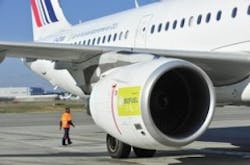Airbus and Air France complete green commercial flight
Combining these technologies helped half the overall CO2 emissions to 54 grams per passenger and kilometer. This is equivalent to a fuel efficiency of 2.2 litres of fuel per passenger and 100 Kilometers.
Bio-fuel is one solution for reducing overall CO2 emissions. Airbus’ alternative fuel strategy is to speed up its commercialization through sustainable bio-fuel value chains. Thanks to several test flights and collaboration with the fuels standards bodies (ASTM and DefStan), today the use of 50 per cent bio-fuel blends are authorized in commercial flights.
A more efficient ATM system could also help reduce the amount of fuel burned by aircraft and therefore the CO2 emitted. Airbus strongly supports the streamlining of ATM and has launched a new subsidiary company, called “Airbus ProSky”, dedicated to the development and support of modern air traffic management (ATM) systems to achieve the highest operational efficiencies with more direct routings resulting in around 10 percent less aircraft fuel consumption, as well as significant reductions in CO2 and noise emissions.
CDA is becoming more widespread as a way to reduce fuel burn. During a CDA procedure, the aircraft descends continuously, avoiding level flight prior to the final approach and requires significantly less engine thrust and therefore less fuel burn.
